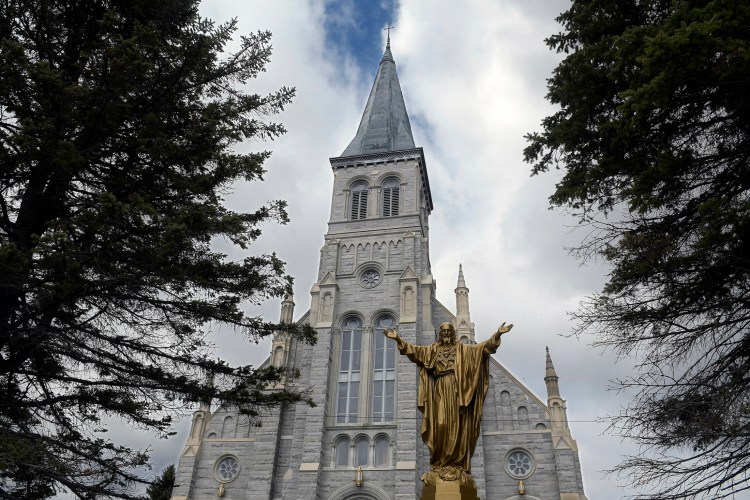Winthrop resident Debbie Sherman made her first visit to Notre Dame Cathedral in Paris on March 23. Less than a month later, she watched it burn on the news.
“My husband came home and said, ‘Boy, good thing we went to Notre Dame when we did,’” Sherman said. “I asked him why and he said, ‘Well, it’s on fire.’”
“I’m not Catholic, but it is an edifice that every person that travels should see,” she added. “It just tears at my heartstrings. Of course, with Easter coming, it’s just that much more devastating.”
Sherman recalled seeing the neighborhood near Notre Dame packed with cafes and people meandering around the narrow nearby streets. She said it was hard to believe the place she had just visited was the same one she was seeing on the news.
“It’s one thing to see something on TV (where you haven’t been), but another thing to have been just there and to see this,” Sherman said.
The effect was also felt in Maine’s religious community.
“It’s a magnificent building,” said the Rev. John Skehan, pastor of St. Michael’s Catholic Parish, which includes churches in Augusta, Gardiner, Hallowell, Whitefield and Winthrop. “It’s an architectural delight and it’s obviously been around a long time.”

Debbie Sherman holds a photo of herself Tuesday, showing her in front of the Notre Dame Cathedral in Paris in March. Sherman resides in Winthrop. Kennebec Journal photo by Andy Molloy
Bishop Robert Deeley, of the Diocese of Portland, issued a statement Monday noting the structure’s iconic status.
“France has lost a cultural icon that has stood for over eight centuries, and the world has lost a beloved symbol of Christianity,” he said in the statement. “The Cathedral of Notre Dame served as a beautiful center of faith for countless generations of Catholics and as a source of inspiration and architectural brilliance for the millions of tourists who were blessed to visit it. It is difficult to process this tragic loss.”
Michael Grillo, professor of art history at the University of Maine, said the cathedral often is discussed among art historians. “Then something like this happens and you realize that everyone is affected,” he said. “You realize that even though it’s not everybody’s focus, everyone feels this loss.
“Christian, non-Christian, secular, whatever,” Grillo added, “this was a cultural marker and it meant so much to so many.”
There is a clear global cultural effect, but Skehan noted that the cathedral is more than just a “tourist attraction.”
“It serves as the local parish for many, many people,” he said. “It was hard to hear reporters saying that’s where they go to church, or where they were married. It has played a huge role in many people’s lives. My heart and prayers went out to those people who called Notre Dame their church.”

Father John Skehan
Skehan did note, however, that while churches are sacred places — “where people celebrate weekly and important moments in their lives” — the congregation also is “church.”
“Even if we don’t have a building to be in, we are still the church,” he said. “There is history — people have made donations of things like stained glass windows or have purchased items we use at Mass — and obviously there would be sadness. It would be a devastating thing for the parish” to have a fire at St. Augustine, he said, referring to one of his parish’s churches in Augusta.
“But hopefully from those ashes would come new life, some hope, some faith, and we’d pick up the pieces,” Skehan added. “That’s what we’re beginning to celebrate.”
He referred to this being Christianity’s Holy Week, with Maundy Thursday celebration of the Last Supper, Good Friday commemorating the death of Jesus Christ and the Easter Sunday celebration of his resurrection.
“(A fire at St. Augustine’s) would be a really painful — but concrete — way people would have to see as walking in our Lord’s footsteps,” Skehan said.
St. Augustine Church, located at 75 Northern Ave., hosted first celebration of Mass in December 1916, more than a century ago. That might seem old, but the first cornerstone for Notre Dame was laid in 1160 and it was officially designated a historic monument in 1862 – 54 years before St. Augustine was completed.
Grillo, who has been to Notre Dame numerous times, said that though the roof burned off and the spire fell, the structure is “incredibly well engineered.”
“I really do think this building is going to survive relatively well,” he said. “Any loss is a horrendous loss; there’s no question. The outpouring that’s happening now (with more than $700 million pledged for the restoration effort by press time), I’m hoping it sustains the restoration, which will take a decade.”
While it might be hard to quantify Notre Dame’s meaning for those who haven’t been there, there are parallels.
“The Vatican is to Rome like Notre Dame is to Paris. It’s like the St. Patrick’s Cathedral in New York City, but St. Patrick’s is minuscule compared to Notre Dame,” Sherman said. “Everybody that goes to Paris wants to see the Notre Dame Cathedral and the Eiffel Tower. Those are the two places people want to see.”
To emphasize the what the French are feeling in wake of the fire, Grillo noted the similarity of watching the World Trade Center towers collapse in 2001. While that horrific terrorist attack led to loss of life that cannot be equated to Notre Dame, he said, seeing iconic structures fall would be similar.
“As far as cultural import, we’ve been through something like that with the World Trade Center,” Grillo said. “The World Trade Center – politics aside, loss of human life that cannot be put aside – that was a powerful icon of New York City and, by extension, of the United States.”
Rob Montana — 621-5725
Twitter: @rjmontana
Send questions/comments to the editors.



